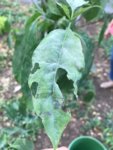Nybonsai12
Masterpiece
Looking for help. Not a bonsai, landscape tree at my parents house that they are upset about. What is this? I couldn’t find anything that looked exactly like this while searching. It looks like a combo of the black spots like in the pic and what appears like powdery mildew in some other spots.
Very wet past 6 weeks. It’s next to an azalea with leaf gall also which I didn’t think there was treatment for other than picking off infected leaves before they turn white, which theirs already have. It’s a mess!
Any help is appreciated.


Very wet past 6 weeks. It’s next to an azalea with leaf gall also which I didn’t think there was treatment for other than picking off infected leaves before they turn white, which theirs already have. It’s a mess!
Any help is appreciated.


